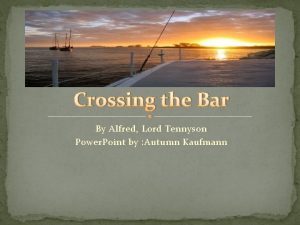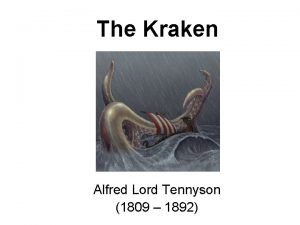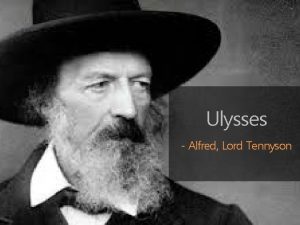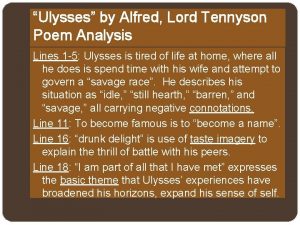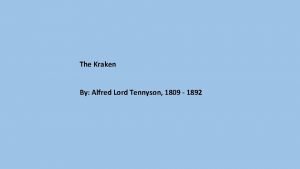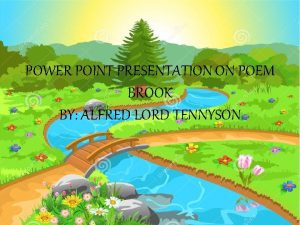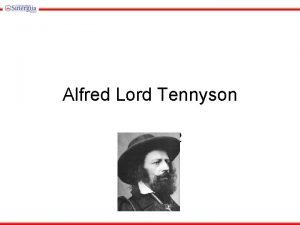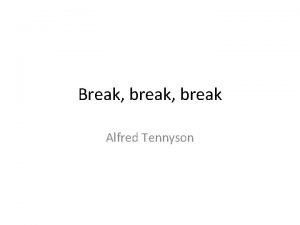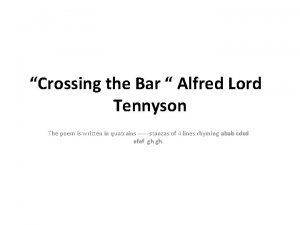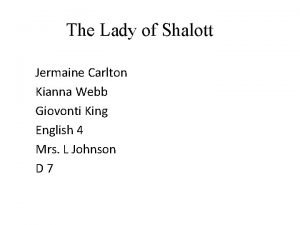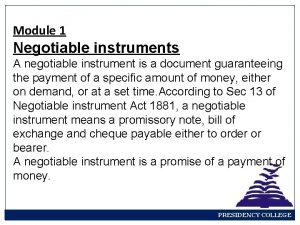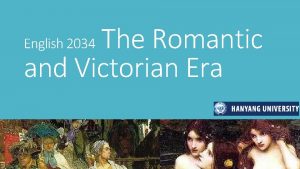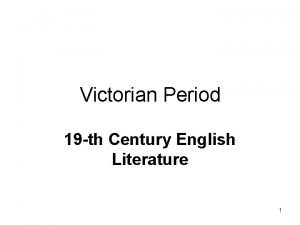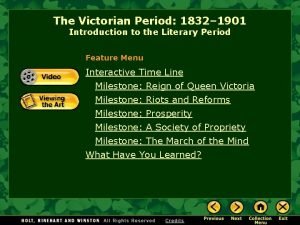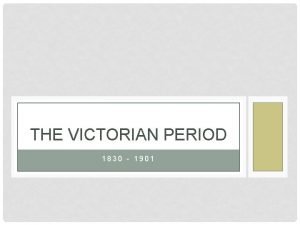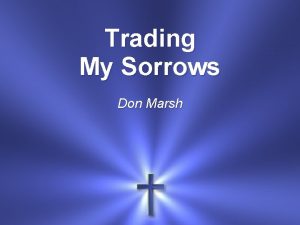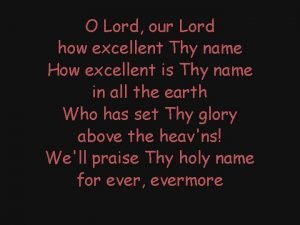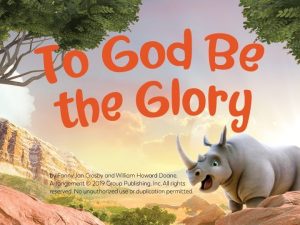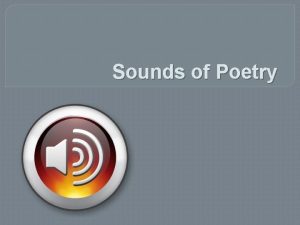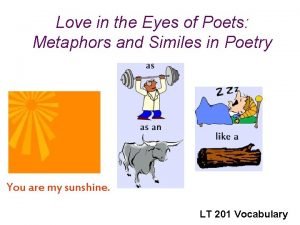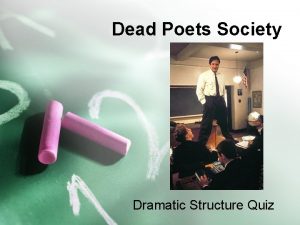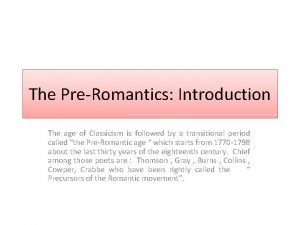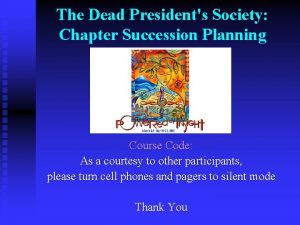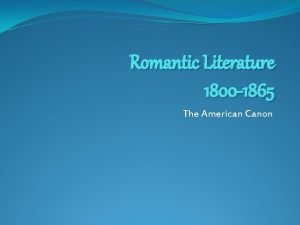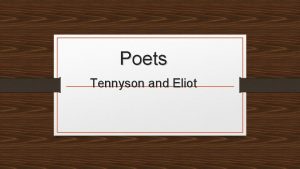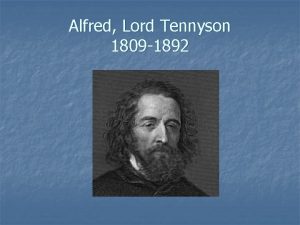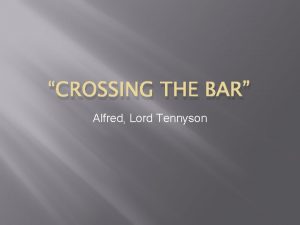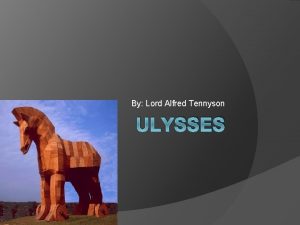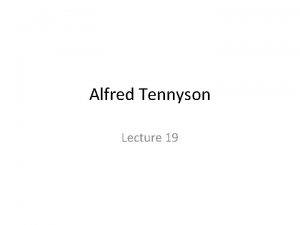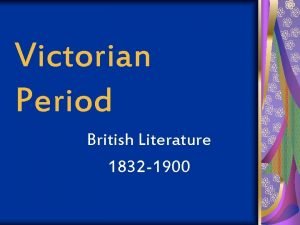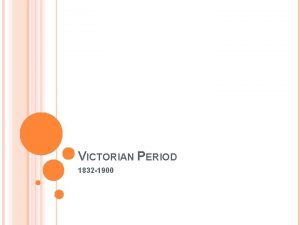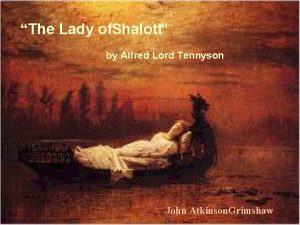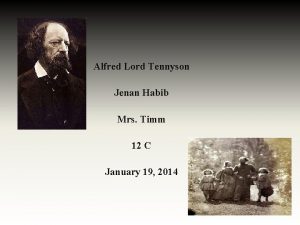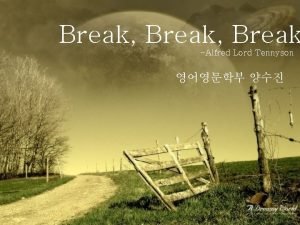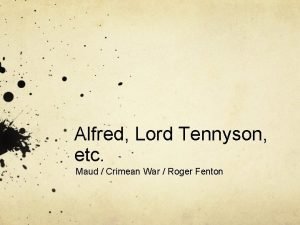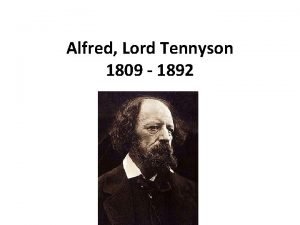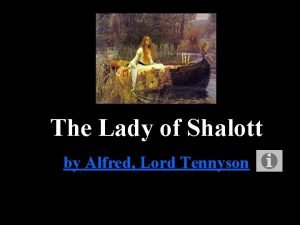Victorian Period Poets Alfred Lord Tennyson Tennyson Crossing









































- Slides: 41

Victorian Period Poets: Alfred, Lord Tennyson: Tennyson “Crossing the Bar” and “Tears, Idle Tears” Gerard Manley Hopkins: Hopkins “Pied Beauty” Matthew Arnold: Arnold “Dover Beach” A. E. Housman: Housman “To an Athlete Dying Young”

“Crossing the Bar” Written by Alfred, Lord Tennyson

ABOUT ALFRED, LORD TENNYSON Ø In 1831 Tennyson left Ø By age 12, he had Ø He was shy in college and went to be written a 6, 000 line epic but still expressed with his dad, who was poem. himself through his sick and dying. Ø Whenever he felt poetry. troubled, he would turn Ø He became a part of an Ø After his father died, he decided to be a poet full to poetry. elite group of students time. Ø His father had a long known as “The Ø After he published history of mental Apostles. ” first volumes of poetry, instability and was Ø He gained confidence in he got mixed reviews involved with alcohol his abilities and around and did not take criticism and drugs. that time, his closest very well. Ø This was another friend, Arthur Henry reason why he Hallam, became engaged Ø He also found out that his best friend, Arthur wrote poetry. to his sister. Henry Hallam had died suddenly.

ABOUT ALFRED, LORD TENNYSON Ø Tennyson fell into a long depression Ø Wrote some of his best poetry Ø “ten years’ silence” Ø When he was 32, he published new poems and the reviews were pretty positive. Ø He ended up becoming Queen Victoria’s poet laureate after William Wordsworth. Ø He finally became confident in his work and married Emily Sellwood. Ø The rest of his life he enjoyed extraordinary respect Ø Tennyson was 81 when he wrote “Crossing the Bar” and it was just a few days before his death. Ø He asked that it be placed at the end of every edition of his work.

Lit Terms

Tone, Symbol, Rhyme Scheme Tone: An author’s attitude toward his or her subject matter or the audience. This is conveyed through word choice, punctuation, sentence structure, and figures of speech. Symbol: Any object, person, place, or experience that exists on a literal level but also represents something else, usually something abstract. Rhyme Scheme: The pattern that end rhymes form in a stanza or a poem

“Crossing the Bar” The overall tone of this piece is not sad but basically saying do not be sad for Tennyson when he moves on from this world.

“Crossing the Bar” A B But such a tide as moving seems asleep, Too full for sound and foam, When that which drew from out the boundless deep Turns again home. C D Twilight and evening bell, And after that the dark! And may there be no sadness of farewell, When I embark; E F For though from out our bourne of Time and Place The flood may bear me far, I hope to see my Pilot face to face When I have crossed the bar. G H Rhyme Scheme Sunset and evening star, And one clear call for me! And may there be no moaning of the bar, When I put out to sea,

“Crossing the Bar”

Tears, Idle Tears by Alfred Lord Tennyson Shelby Carroll & Sam West

Tears, Idle Tears Alfred Lord Tennyson Tears, idle tears, I know not what they mean, Tears from the depth of some divine despair Rise in the heart, and gather to the eyes, In looking on the happy Autumn-fields, And thinking of the days that are no more. Fresh as the first beam glittering on a sail, That brings our friends up from the underworld, Sad as the last which reddens over one That sinks with all we love below the verge; So sad, so fresh, the days that are no more. Ah, sad and strange as in dark summer dawns The earliest pipe of half-awakened birds To dying ears, when unto dying eyes The casement slowly grows a glimmering square; So sad, so strange, the days that are no more. Dear as remembered kisses after death, And sweet as those by hopeless fancy feigned On lips that are for others; deep as love, Deep as first love, and wild with all regret; O Death in Life, the days that are no more. Mood Imagery Setting

Mood: the emotional quality of a literary work. Imagery: the “word pictures” that writers create to evoke an emotional response. Setting: the time and place in which the events of a literary work occur.

Meet The Author • Turned to poetry whenever he felt troubled • He produced a 6, 000 line poem at the age of 12 • His father had a long history of mental illness • His grandfather virtually disinherited his dad, turning him to drugs and alcohol and he often took out his disappointment on the family • At college, he was in a group called “The Apostles” • Perfected his craft during his “ 10 years Silence” after his brother in law died of a stroke

Connecting to the Era view • Has a pessimistic • Dark thoughts and imagery

PIED BEAUTY GERARD MANLEY HOPKINS SPRUNG RHYTHM, ALLITERATION, RHYME SCHEME CASSIDY HUTTON AUTUMN ZONKER

GERARD MANLEY HOPKINS • Of the Victorian age, but displayed many modern era characteristics • Wrote “Pied Beauty” in 1877 • First published twenty-nine years after his death in 1918 • Hopkins often writes about religion, nature and the parallels between the two • Shown in “Pied Beauty” • Burned his poems to show his religious devotion

PIED BEAUTY • “Pied Beauty” is one of the first poems that Hopkins wrote in sprung rhythm • Rhythms similar to normal speech infused with many religious alliterations and characteristics and enthusiasm • Shortened sonnet – a popular form of writing by Hopkins • ‘Thank You’ to God for the simplest pleasures the beautiful Earth has to offer

PIED BEAUTY

SPRUNG RHYTHM • Invented term and technique • Meter in which each foot contains one stressed syllable, the first, and any number of unstressed syllables • Fuses words together in order to have the maximum amount of meaning and accents using the minimum number of words • Start and stop rhythm • Example: Fresh-firecoal chestnut-falls • Believed was rhythm of natural speech

ALLITERATION • Repetition of consonant sounds at the begging's of words • Enhances words while creating a musical effect • Line 1: "Glory" and "God" • Line 2: "Couple-colour" and "cow" • Line 4: "Fresh-firecoal" "falls" and "finches'" • Line 5: "Plotted, " "pieced, " and "plough“ • "fold" and "fallow" • Line 6: "Trades, " "tackle, " and "trim" • Line 7: "Spare" and "strange" • Line 8: "Fickle" and freckled" • Line 9: "Swift, " "slow, " "sweet, " and "sour. " “ • Line 10: "Fathers-forth"

RHYME SCHEME • End rhymes form in a stanza or a poem • ABCABC DBEDE • Last line "Praise Him" is set apart • own indentation far to the right • “Amen" of a religious prayer

Pied Beauty By: Gerard Manley Hopkins Page: 953 Glory be to God for dappled things— For skies of couple-colour as a brinded cow; For rose-moles all in stipple upon trout that swim; Fresh-firecoal chestnut-falls; finches’ wings; Landscape plotted and pieced—fold, fallow, and plough; And áll trádes, their gear and tackle and trim. All things counter, original, spare, strange; Whatever is fickle, freckled (who knows how? ) With swift, slow; sweet, sour; adazzle, dim; He fathers-forth whose beauty is past change: Praise Him. Angela Hess & Tara Plummer

Hopkins • His work was published 30 years after his death • He studied at Oxford University: • Latin and Greek and was exposed to the newest ideas in poetry and theology • Hopkins burned most of his poetry in a display of religious devotion • For 7 years he wrote no new poetry • “terrible sonnets” expressed despair at the poet’s inability to fully escape the prison of the self

Literary Devices Sprung rhythm- a rhythm in poetry that is similar to the rhythm of speech Alliteration- the repetition of consonant sounds anywhere in a word Rhyme scheme-pattern of rhyming at the end of lines

Pied Beauty Glory be to God for dappled things— For skies of couple-colour as a brinded cow; For rose-moles all in stipple upon trout that swim; Fresh-firecoal chestnut-falls; finches’ wings; Landscape plotted and pieced—fold, fallow, and plough; And áll trádes, their gear and tackle and trim. All things counter, original, spare, strange; Whatever is fickle, freckled (who knows how? ) With swift, slow; sweet, sour; adazzle, dim; He fathers-forth whose beauty is past change: Praise Him. ABCABCDBCDC

y e s l Ke k n a h S n e ur a L & e m a D Dover Beach Matthew Arnold Pg. 996

DOVER BEACH • Written by Matthew Arnold estimated 1851 (on his honeymoon while visiting) • Transition from faith to science and technology • Dover Beach is an actual beach located about 20 miles from France • Dover Beach is known for chalk white cliffs

Matthew Arnold • Many pieces were influenced by economic and social changes throughout Europe • Son of the most renowned Educator in Victorian England • Attended Oxford on a scholarship; wasn’t a serious student • First two published volumes were published anonymously

Matthew Arnold • Withdrew first two volumes because he was such a perfectionist he was unsatisfied with his work • Became inspector of schools to support his family • Traveled wretched road, and stayed at dreary inns for 35 years- inspiration for poems • 1853 first poem published with his name

Matthew Arnold • Famous dictum – poetry should not only express an authors feelings but should also “animate and ennoble” it’s readers • 1857 - elected to poetry chair at Oxford University • Believed in board education of arts and science to further enable a man to know himself and the world

DOVER BEACH • Meter: a regular pattern of stressed and unstressed syllables that gives a line of poetry a more or less predictable rhythm • Apostrophe: figure of speech in which a speaker addresses an inanimate object, idea, or absent person • Allusion: a reference to a well known character place or situation from history, music, art, or another work of literature

“The best poetry will be found to have a power of forming, sustaining, and delighting us, as nothing else can. ” - Matthew Arnold

TO AN ATHLETE DYING YOUNG

LITERARY TERMS Personification – A figure of speech in which an animal, an object, a force of nature, or an idea is given human characteristics. Consonance – The repetition of consonant sounds, typically at the end of nonrhyming words and preceded by different vowel sounds. Rhythm – The pattern of beats created by the arrangement of stressed and unstressed syllables, especially in poetry.

Eyes the shady night has shut The time you won your town the race We chaired you through the marketplace; Cannot see the record cut, And silence sounds no worse than cheers After earth has stopped the ears: Man and boy stood cheering by, And home we brought you shoulderhigh. Now you will not swell the rout Of lads that wore their honors out, Runners whom renown outran To-day, the road all runners come, And the name died before the man. Shoulder-high we bring you home, And set you at your threshold down, So set, before its echoes fade, Townsman of a stiller town. The fleet foot on the sill of shade, And hold to the low lintel up Smart lad, to slip betimes away The still-defended challenge-cup. From fields were glory does not stay And early though the laurel grows And round that early-laureled head It withers quicker than the rose. Will flock to gaze the strengthless dead, And find unwithered on its curls The garland briefer than a girl's.

ALFRED EDWARD HOUSMAN

To An Athlete Dying Young Jacob Bollman Austin G-rams

Personification: figure of speech in which an animal, an object, a force of nature, or an idea is given human characteristics Rhythm: the pattern of beats creating by the arrangement of stressed and unstressed syllables especially in poetry. Consonance: the repetition of consonant sounds typically at the end of non-rhyming words

RHYTHM (iambic pentameter) The time you won your town the race We chaired you through the market-place; Man and boy stood cheering by, And home we brought you shoulder-high.

PERSONIFICATION Eyes the shady night has shut (line 13) CONSONANCE The fleet foot on the sill of shade (line 22) Laurel Wreath

A. E. Housman Somber poetry and classical scholarship Adalbert diedtyphoid fever Latin professor at Trinity college
 Crossing the bar by alfred lord tennyson
Crossing the bar by alfred lord tennyson The kraken alfred lord tennyson
The kraken alfred lord tennyson Tears idle tears 해석
Tears idle tears 해석 Ulysses poem symbolism
Ulysses poem symbolism Battening on huge sea worms
Battening on huge sea worms Meaning of foamy flake
Meaning of foamy flake Alfred lord tennyson born
Alfred lord tennyson born Break break break alfred lord tennyson
Break break break alfred lord tennyson Victorian period floral design
Victorian period floral design Byzantine floral history
Byzantine floral history Crossing the bar analysis
Crossing the bar analysis The lady of shalott meaning
The lady of shalott meaning Difference between special crossing and general crossing
Difference between special crossing and general crossing Romantic age and victorian age
Romantic age and victorian age Critical realism
Critical realism Victorian age introduction
Victorian age introduction Victorian age timeline
Victorian age timeline Victorian period
Victorian period Victorian era literature characteristics
Victorian era literature characteristics Victorian era notes
Victorian era notes Critical vs sensitive period examples
Critical vs sensitive period examples Prehistory timeline
Prehistory timeline Seed of activism
Seed of activism A&p flix activity: propagation of an action potential
A&p flix activity: propagation of an action potential Critical period vs sensitive period
Critical period vs sensitive period Stability period vs measurement period
Stability period vs measurement period Absolute refractory period and relative refractory period
Absolute refractory period and relative refractory period The classical period started from 1750 to 1872
The classical period started from 1750 to 1872 Critical period vs sensitive period
Critical period vs sensitive period Non metal halogen family atomic mass 35
Non metal halogen family atomic mass 35 Trustee period and royal period
Trustee period and royal period Cynthia lightfoot
Cynthia lightfoot Yes yes lord amen
Yes yes lord amen Great is thy name oh lord
Great is thy name oh lord To god be the glory
To god be the glory Aapi poets
Aapi poets The repetition of initial sounds
The repetition of initial sounds Dead poets society metaphors
Dead poets society metaphors Dead poets society quiz
Dead poets society quiz Thomas gray as a romantic poet
Thomas gray as a romantic poet Dead president society
Dead president society Fireside poets definition
Fireside poets definition
